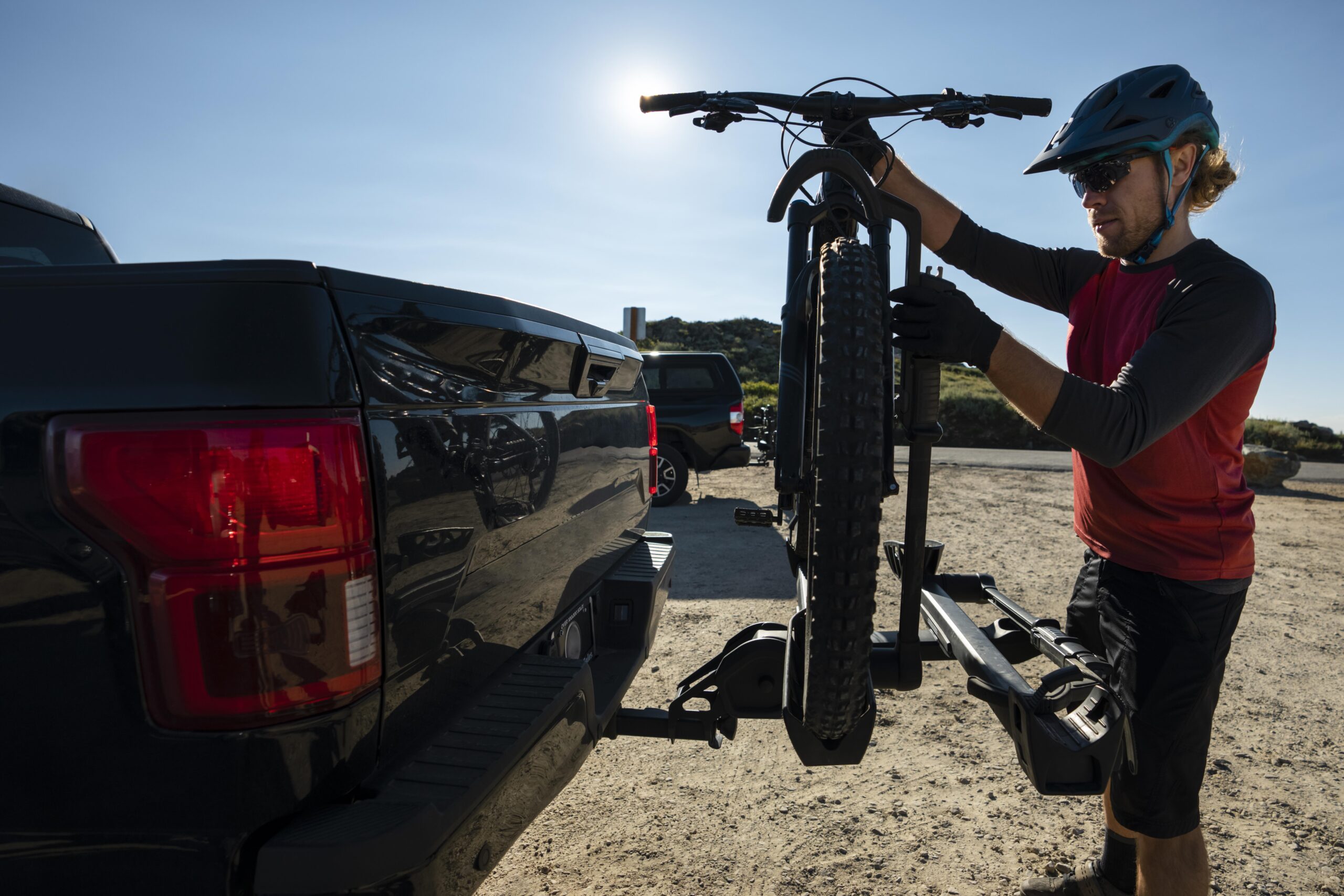Most bike racks can hold between 40 to 120 pounds per bike, depending on the type and design. Hitch-mounted racks generally support the most weight, with platform styles often accommodating up to 60 pounds per bike, making them ideal for heavier bikes like e-bikes. Always check the manufacturer’s specifications for the exact weight limit to ensure safe transport.
Have you ever stared at your bike rack and thought, Can this thing really hold my bikes without turning my road trip into a roadside rescue mission? You’re not alone! Whether you’re hauling a featherlight road bike or a hefty e-bike, understanding your bike rack’s weight limit is the key to stress-free adventures.
But here’s the kicker: not all bike racks are created equal. Some are tough enough to carry your entire cycling crew’s gear, while others might struggle with a single heavy bike. What’s the real deal? Which rack fits your needs? And how can you avoid those dreaded mid-drive mishaps?
Don’t sweat it—we’ve got all the answers lined up for you. Stick around to uncover the secrets to choosing the perfect rack, tips for transporting your gear safely, and surprising insights about the brands you love. Ready to roll? Let’s get started!
What Determines the Weight Capacity of a Bike Rack?
So, you’ve got a shiny new bike rack, but how much can it really carry? The answer lies in a mix of science, engineering, and common sense. Let’s break it down:
- Materials and Construction Quality: Is your rack built like a tank or more like a tin can? Heavy-duty materials like steel or aluminum can handle more weight than cheaper plastic components.
- Mounting Type: Hitch-mounted racks are the weightlifting champs of the bike rack world, while trunk-mounted and roof racks have their limits.
- Vehicle Compatibility: Even the strongest rack is only as good as the vehicle it’s attached to. Make sure your car or truck can handle the load too!
Key Factors to Consider
When figuring out how much your bike rack can hold, it’s not just about the rack itself. Keep these in mind:
- Bike Weight: Are you hauling a sleek road bike or a beefy e-bike? Heavier bikes require racks with higher weight limits.
- Number of Bikes: The more bikes, the merrier—but also heavier! A rack might handle one e-bike easily but struggle with three.
- Rack Design and Stability: Platform-style racks tend to offer better weight distribution and stability, while hanging-style racks might not be ideal for heavier bikes.
Comparing Different Types of Bike Racks
Not all bike racks are created equal—some are built to handle the heavy lifters, while others prefer a lighter load. Let’s explore the lineup to find the one that matches your needs (and your bikes) perfectly:
Hitch-Mounted Racks
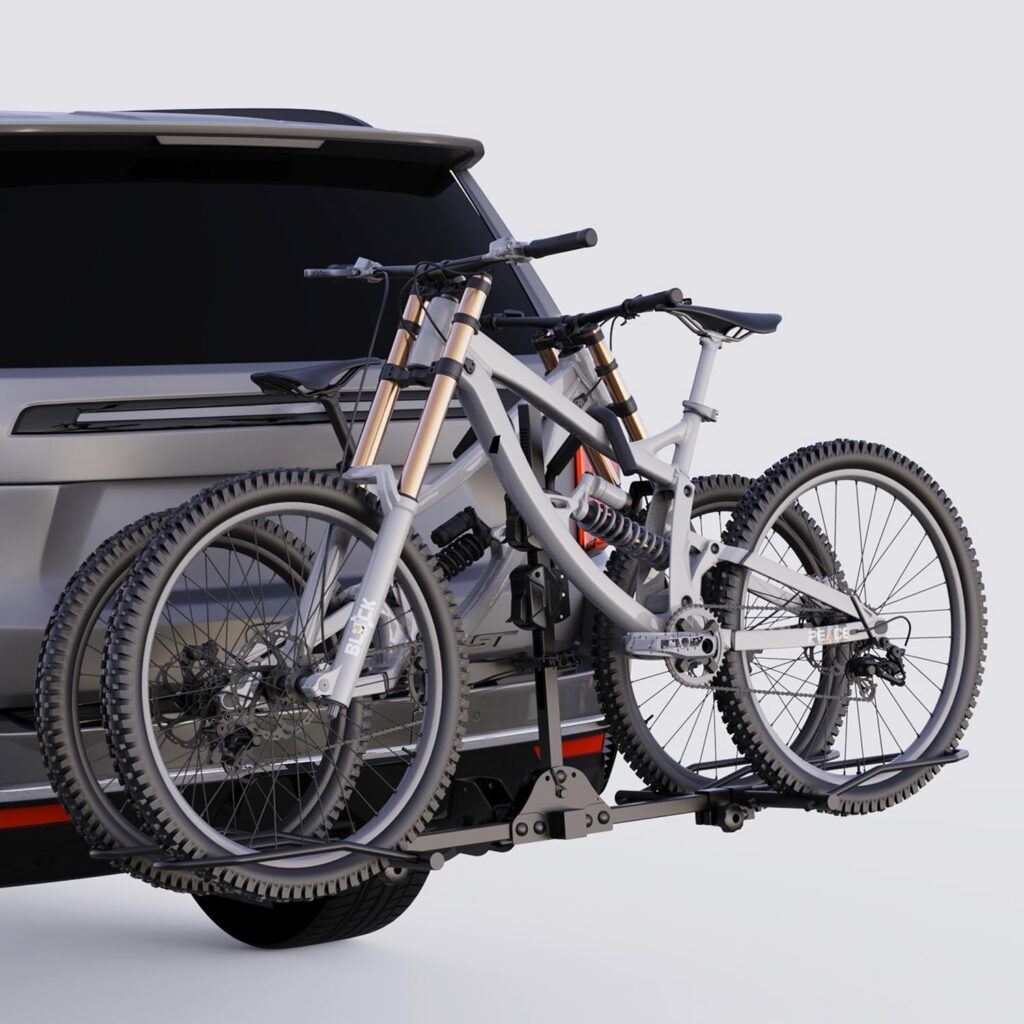
The MVP of bike racks, hitch-mounted designs are all about stability and strength.
- Platform or Tray-Style Racks: These are the bodybuilders of the bike rack world, with weight limits often reaching 60 lbs per bike—perfect for those beefy e-bikes.
- Hanging-Style Racks: Light and simple, but not ideal for heavy bikes. Think of them as the minimalist option for casual riders.
- Vertical Bike Racks: Need to haul a whole team’s worth of bikes? These racks stack them vertically for max efficiency, but make sure your hitch (and your patience) can handle it!
Roof-Mounted Racks
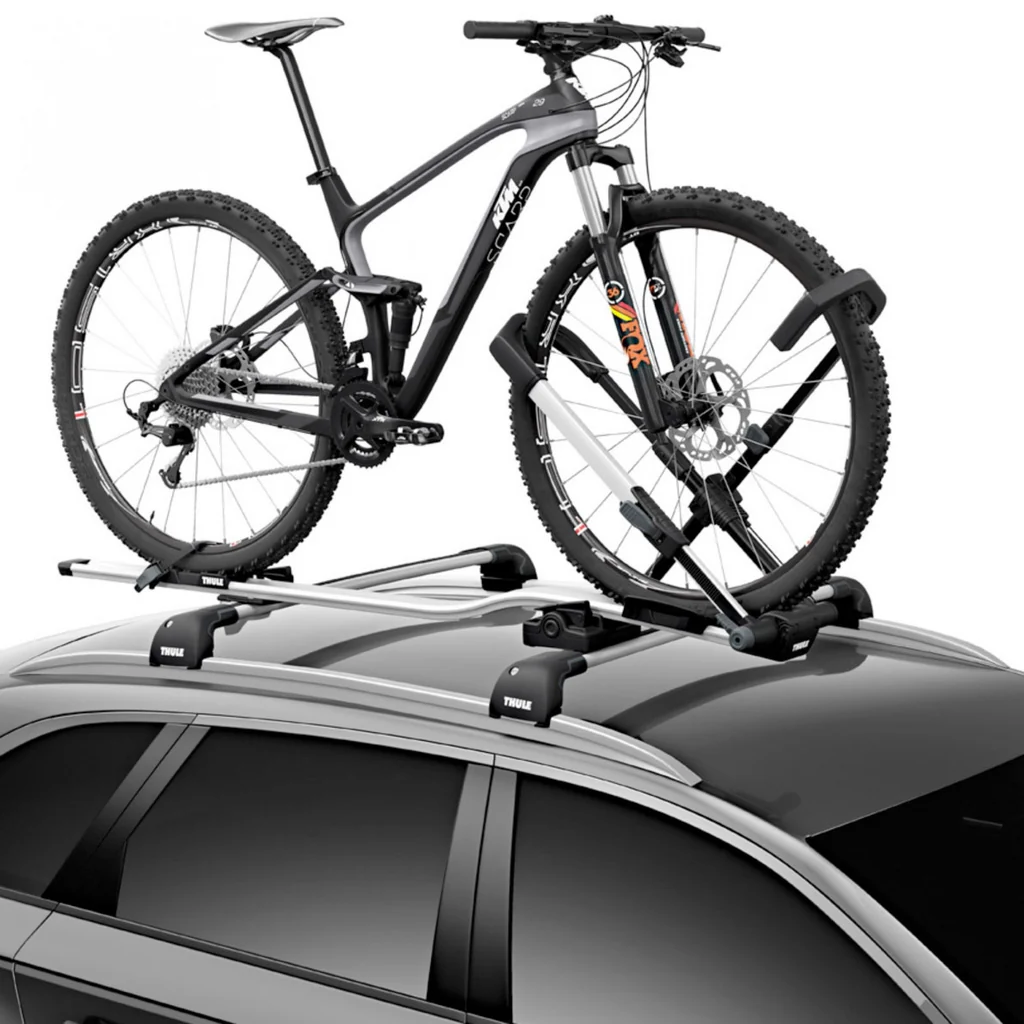
For those who like to keep their bikes riding high—literally.
- Pros and Cons: Roof racks are great for keeping your car’s rear clear and can handle most standard bikes, but lifting a heavy e-bike overhead? That’s a workout you didn’t ask for!
- Typical Weight Limits: Usually between 40–50 lbs per bike, depending on the rack and your vehicle’s roof strength.
Trunk-Mounted Racks
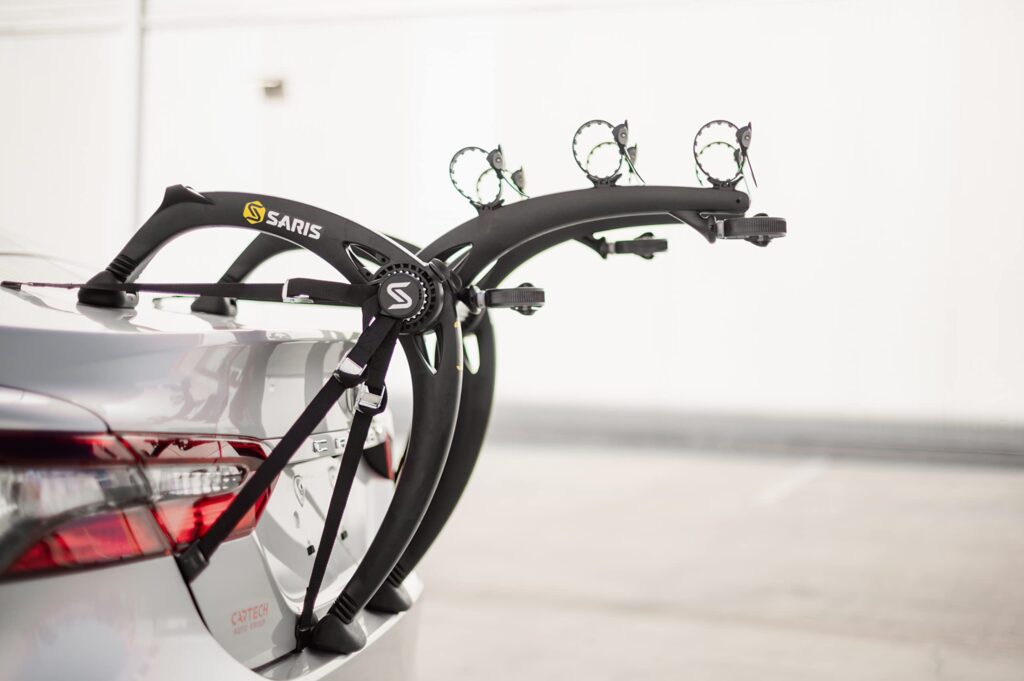
A budget-friendly option for those without a hitch.
- Weight Limits: These racks are best for lightweight bikes, with typical limits around 35 lbs per bike.
- Tips for Securing: Properly tighten those straps! A loose rack can mean a bumpy ride for your bike.
Spare Tire Racks
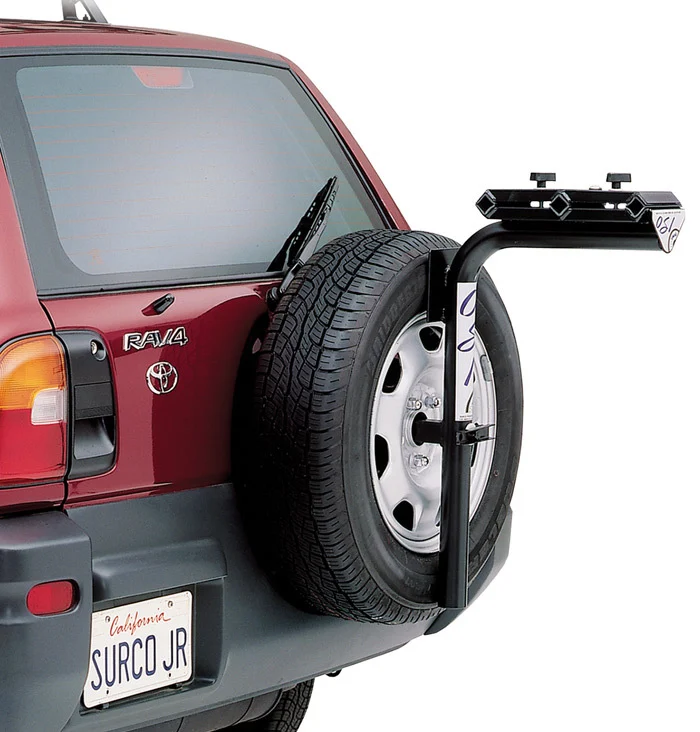
Got a spare tire? Use it! These racks attach directly to the spare tire on your vehicle.
- When to Use: Ideal for SUVs and off-road vehicles with exposed spare tires.
- Weight Limitations: Most handle 30–40 lbs per bike, but double-check that your spare can handle the extra load!
Boot-Mounted Racks
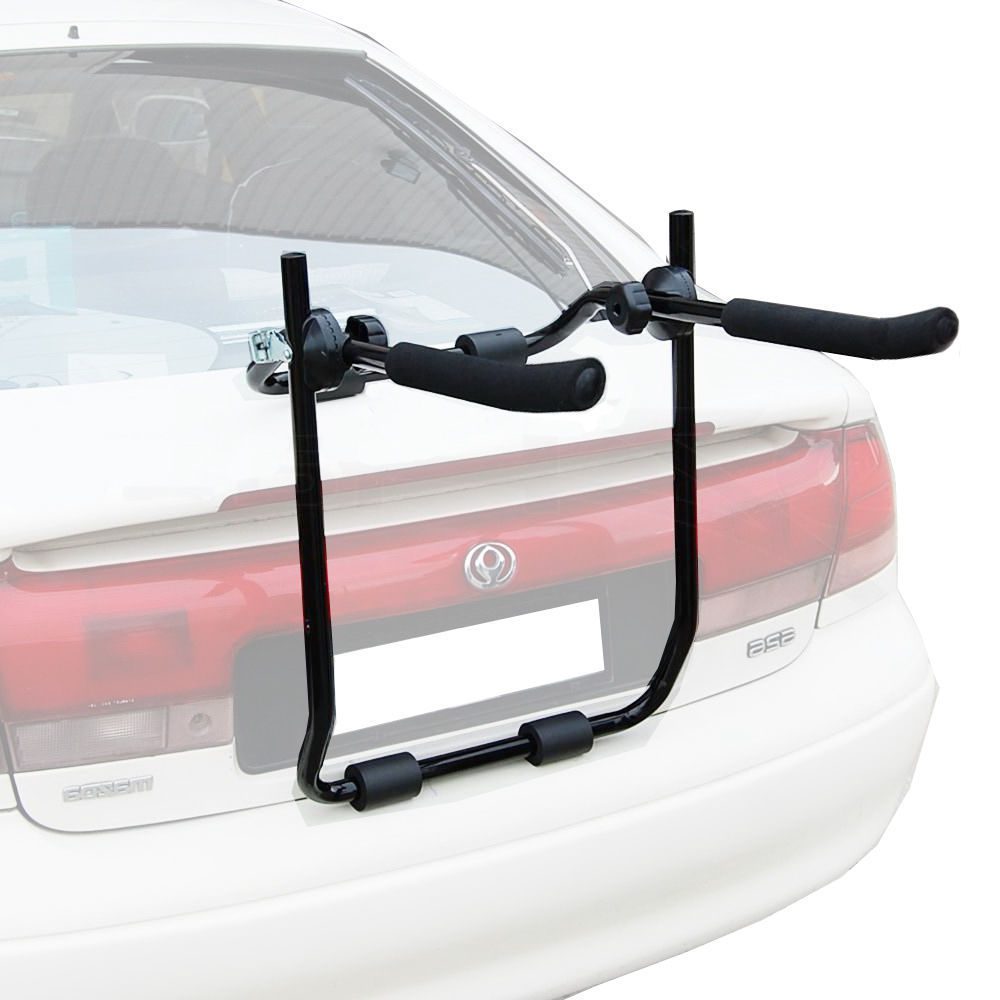
Lightweight and portable, boot-mounted racks are great for short trips.
- Usage Scenarios: Perfect for a quick jaunt to the park or trail with one or two bikes.
- Weight Capacities: Generally max out at 30 lbs per bike—best for lightweight models.
How Much Weight Can Popular Bike Rack Brands Hold?
When it comes to bike racks, not all brands are created equal—some are more heavy-duty, while others are perfect for lighter loads. Let’s break down the weight limits of some of the top bike rack brands, so you can pick the perfect one to carry your bikes safely and securely.
Yakima Bike Racks
Yakima racks are built to handle some serious weight while keeping your bikes safe and secure on the road.
- Popular Models:
- Yakima FullSwing: Holds up to 60 lbs per bike (great for e-bikes!).
- Yakima RidgeBack: A bit lighter, holding up to 35 lbs per bike.
- Why Yakima: These racks are known for their stability, ease of use, and the ability to carry multiple bikes, including heavier models.
Thule Bike Racks
Thule racks are designed for those who want durability and style without compromising on weight limits.
- Typical Weight Limits:
- Thule T2 Pro XT: Supports up to 60 lbs per bike, making it a solid choice for mountain bikes and e-bikes.
- Thule Helium Pro: A lighter, more compact option with a 35 lbs per bike limit.
- Why Thule: Sleek, easy to use, and with great customer support, Thule racks are a favorite for cyclists who want style and strength.
Kuat Bike Racks
Kuat racks are the luxury SUV of bike racks—stylish, sturdy, and ready for some heavy lifting.
- Weight Considerations:
- Kuat NV 2.0: This heavy-duty rack holds up to 60 lbs per bike, and it’s built to last.
- Kuat Sherpa: A lighter option, supporting up to 40 lbs per bike, perfect for casual cyclists.
- Why Kuat: With their sleek design and premium features, Kuat racks are perfect for cyclists who want a high-end, durable solution for transporting bikes.
Saris Bike Racks
Saris racks are like the dependable workhorses of the bike rack world—built to carry your bikes safely and securely.
- Common Weight Limits:
- Saris SuperClamp EX: Holds up to 60 lbs per bike, making it a great choice for heavier bikes.
- Saris Bones: Lightweight, with a 35 lbs per bike limit, perfect for lighter bikes or shorter trips.
- Why Saris: Known for their solid construction and easy installation, Saris racks are a go-to for cyclists who want reliable, budget-friendly options.
Fiamma Bike Racks
If you’ve got an RV or a heavy bike, Fiamma racks are the ones you want to turn to.
- Why Fiamma?:
- Designed specifically for RVs, Fiamma racks are built to hold heavier bikes, with some models handling up to 50 lbs per bike.
- They’re especially popular among RVers who need to transport bikes over long distances without worrying about weight limits.
Hollywood Racks
Hollywood Racks are all about getting the job done with specialized designs that cater to all types of cyclists.
- Weight Capabilities:
- Hollywood Racks Sport Rider: A strong option, holding up to 45 lbs per bike.
- Hollywood Racks Baja: Great for lighter loads, with a weight limit of 30 lbs per bike.
- Why Hollywood: Known for affordable, well-designed racks that get the job done, Hollywood Racks is a popular pick for families and cyclists on a budget.
How Many Bikes Can a Rack Hold?
When it comes to bike racks, more bikes usually means more fun—but it also means thinking carefully about how much weight you’re hauling. Let’s take a closer look at how many bikes your rack can carry without tipping over into chaos. Spoiler alert: it’s not just about the weight, but also the design and your vehicle’s limits.
3-Bike Racks
Perfect for small groups, families, or when you’re feeling extra generous with your riding buddies.
- Best Use Cases: Ideal for the occasional weekend getaway or family outings where you’ve got three bikes to transport.
- Typical Weight Capacity: Most 3-bike racks can hold anywhere from 90 to 150 lbs, depending on the style.
- Why It Works: Whether it’s three lightweight road bikes or a mix of mountain bikes and hybrids, 3-bike racks offer a great balance of weight capacity and convenience without getting too crowded.
4-Bike Racks
When you’re ready to expand your cycling crew and have a bit more room to work with.
- Weight Limits: Expect weight limits of around 120 to 180 lbs, depending on the model.
- Compatibility Considerations: If you’re using a 4-bike rack, make sure your vehicle can handle the extra load. Larger racks might require a stronger hitch or a heavy-duty roof.
- Why It Works: A solid choice for families or groups where everyone wants to bring their bike but still need to travel comfortably.
5- and 6-Bike Racks
For the ultimate cycling squad or family road trips—if you’ve got the crew, we’ve got the racks.
- Ideal for Group Rides or Family Use: If you’re taking the whole neighborhood or extended family along, this is your go-to option.
- Weight and Vehicle Considerations:
- 5-bike racks can usually hold up to 150–250 lbs, while 6-bike racks can go up to 200–300 lbs, but make sure your vehicle’s hitch can handle the bulk.
- Be mindful that the rack’s weight distribution and the number of bikes could affect stability, so it’s best to double-check your rack’s specs.
- Why It Works: For large families or group rides, these racks give you the flexibility to bring everyone’s bike without sacrificing space in the car. Just be prepared for a slightly more crowded ride!
Additional Considerations
Alright, you’ve got your bike rack and you’re ready to hit the road, but wait—there’s a little more to think about! Let’s dive into the nitty-gritty details to make sure your rack and your ride stay in tip-top shape.
How Much Do Bike Racks Weigh?
Just like your bike, your bike rack isn’t immune to the laws of physics—its weight can impact your vehicle’s performance.
- Average Weight of Common Bike Rack Types:
- Hitch-Mounted Racks: Usually between 25–50 lbs, depending on the design and material.
- Roof-Mounted Racks: Lighter, usually around 15–30 lbs, but don’t forget about that extra lifting required!
- Trunk-Mounted Racks: The lightest, typically weighing in at 10–25 lbs.
- How Rack Weight Affects Vehicle Performance:
- Heavier racks may decrease your vehicle’s fuel efficiency and handling, especially if you’re mounting multiple bikes. So, if you’re concerned about that “extra drag,” lighter might be better.
What Is the Lightest Hitch-Mounted Bike Rack?
If you’re all about convenience and not weighing down your vehicle, let’s take a peek at the featherweights of the hitch-mounted rack world.
- Lightweight Hitch-Mounted Options:
- The Kuat Sherpa 2.0 is a top contender, tipping the scales at just 29 lbs—super easy to install and take off, yet strong enough to handle up to 40 lbs per bike.
- The Thule Helium Pro 3 weighs around 18 lbs, and though it’s light, it can still hold 35 lbs per bike. Perfect for casual rides or lighter bikes!
- Why It Works: If you’re looking for something easy to maneuver, these lightweight racks are the perfect choice without compromising too much on bike capacity.
Transporting Heavy Bikes (E.g., E-Bikes)
E-bikes are awesome, but they come with some extra weight. If you’re planning to transport these electric powerhouses, you’ll need specialized racks to avoid any mishaps.
- Specialized Racks for Electric Bikes:
- Hitch-Mounted Racks: Look for racks that can handle 60+ lbs per bike, like the Yakima HoldUp or Thule T2 Pro XT. These bad boys are built for heavy lifting.
- Platform Racks: These often have the most stability and support for heavy bikes, especially when you need to load them yourself.
- Additional Equipment:
- Loading Ramps: Make your life easier by adding a loading ramp to help you lift those heavy e-bikes into place without risking back strain!
- Battery Removal: If you can, remove the e-bike battery before loading to reduce weight and balance your bike more evenly.
Choosing the Right Bike Rack
So, you’re ready to pick the perfect bike rack? It’s like picking the right pair of shoes for a marathon—get it wrong, and things get uncomfortable. But fear not! Here’s a simple guide to finding a rack that suits your bikes, vehicle, and future adventures.
How to Select the Perfect Rack for Your Needs
Picking the right bike rack is all about making sure it fits your bikes, your car, and your future cycling plans. Let’s break it down!
- Assessing Your Bikes’ Weight and Size:
- Start by checking how heavy and big your bikes are. For example, electric bikes or mountain bikes are typically heavier and require sturdier racks.
- Don’t forget the wheelbase—longer bikes need racks that can handle extra length.
- Matching Racks to Your Vehicle Type:
- If you have a sedan, a trunk mount might be best (lightweight and easy to store!).
- For a hatchback or SUV, a hitch-mounted rack might be the way to go, offering stability and a solid fit.
- Roof-mounted racks are perfect for vehicles with higher clearance, but remember, you’ll need a bit of height to load and unload.
- Future-Proofing Your Investment:
- Think ahead! Will you want to transport more than one bike soon? Opt for a multi-bike rack that can hold 3, 4, or even 5 bikes. It’s like future-proofing your cycling adventures—because, let’s face it, more bikes = more fun!
Ensuring Safe and Reliable Bike Transport
You’ve made it to the end—now let’s wrap things up with a few final tips for safe and stress-free bike transportation. Whether you’re hauling your trusty road bike, an e-bike, or your whole cycling squad, understanding weight limits and ensuring everything is securely fastened is key to a smooth ride.
Recap of the Importance of Understanding Weight Limits
- Know Your Limits: Just like lifting weights at the gym, overloading your bike rack can lead to some serious trouble (and we’re not talking about a flat tire!).
- Match Your Rack to Your Ride: From roof racks to hitch mounts, make sure your rack can handle the weight and size of your bikes.
- Keep It Balanced: Unevenly loaded racks are a recipe for disaster—keep things secure and balanced for smooth sailing on the road.
Final Tips for Safe Installation and Use
- Double-Check That Everything’s Tight: Before hitting the road, give your bike rack and bikes a little shake test. If something’s loose, tighten it up!
- Mind the Clearance: If you’re using a roof rack, be mindful of low-clearance areas like garages or drive-thru windows.
- Monitor While Driving: On longer trips, make sure to check your bikes now and then to avoid any surprises.
- Locking Bike Hitch Rack - 17/03/2025
- Bicycle Protective Gear for Adults - 17/03/2025
- How to Find Bike Trails - 16/03/2025


